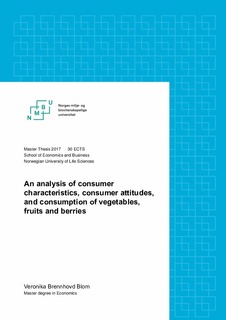| dc.description.abstract | This study investigated the relationship between characteristics, attitudes and lifestyle choices and consumption of vegetables, fruits and berries to identify possible factors that could be used for designing effective policy interventions. Data from Norwegian Monitor survey was used for estimating logistic regression models for vegetables and fruits/berries consumption.As potential determinants of consumption of vegetables, fruits and berries (F&V), price, income, gender, age, regions, households size, marital status, presence of children, educational level, physical activity, smoker, health consciousness, interest for magazines about health and diet, convenience, taste and quality are examined.
The marginal effects at mean analysis revealed that factors such as female, bachelor or master
degree, health consciousness, interest for reading magazines about health and diet increase probability for consuming vegetables at least twice per day. Factors households with 5 members, convenience, taste, and Eastern, Western, Middle or Northern part of Norway as place of residence decrease the probability of consuming vegetables at least twice per day. For fruits/berries, the marginal effects at mean analysis revealed that factors such as female, physical activity, health consciousness and interest for reading magazines about health and diet increase probability of consuming fruits/berries at least twice per day. Factors such as price, smoker, convenience, taste, and Eastern, Western, Middle or Northern part of Norway as place of residence decrease the probability of consuming fruits/berries at least twice per day.
These results suggest that policy instruments such as taxes, subsidies and health information could be effective in increasing consumption of F&V. | nb_NO |

